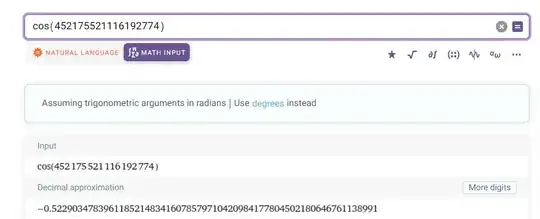As Hans Lundmark pointed out, the problem is caused by converting the argument to a C double before doing the calculation.
But if you don't want to bring in a high-precision math library, there's a way (at least in Python) to calculate a more accurate value by using the sum-of-angles identities.
from math import cos, sin
def cossin(x):
'''
Return (cos(x), sin(x)) more accurately.
'''
if abs(x) < 2 ** 53:
# All integers below this threshold are represented exactly,
# so just use the normal math module functions.
return (cos(x), sin(x))
else:
a = float(x)
b = x - int(a) # the approximation error
# a is a float, so use the normal math functions.
cos_a = cos(a)
sin_a = sin(a)
# for b, call recursively in case it can't be represented as float
cos_b, sin_b = cossin(b)
return (cos_a * cos_b - sin_a * sin_b, cos_a * sin_b + sin_a * cos_b)
This agrees pretty closely with WolframAlpha's result.
>>> cossin(452175521116192774)
(-0.5229034783961185, -0.8523919006426797)
An alternative approach is to use a high-precision approximation of π to reduce the argument modulo 2π. (In Python, you can use the Fraction class to store your approximation. This gives you:
$$452175521116192774 \approx 71965969330795778 \times 2\pi + 4.162135302888925$$
And taking the cosine of the reduced argument will give you the correct result.
>>> cos(4.162135302888925)
-0.5229034783961188




